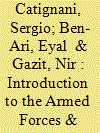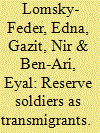| Srl | Item |
| 1 |
ID:
181153


|
|
|
|
|
| Summary/Abstract |
This Armed Forces & Society forum is dedicated to exploring recent trends in the characteristics of military reserves and of the changing character of reserve forces within the armed forces within the military, the civilian sphere, and in between them. To bring new and critical perspectives to the study of reserve forces and civil–military relations, this introduction and the five articles that follow draw on two organizing conceptual models: The first portrays reservists as transmigrants and focuses on the plural membership of reservists in the military and in civilian society and the “travel” between them. The second model focuses on the multiple formal and informal compacts (contracts, agreements, or pacts) between reservists and the military.
|
|
|
|
|
|
|
|
|
|
|
|
|
|
|
|
| 2 |
ID:
082696


|
|
|
|
|
| Publication |
2008.
|
| Summary/Abstract |
This article suggests a new perspective for examining the particular social and organizational characteristics of military reserves forces and the special experiences of serving in the reserves. To illustrate the unique social position of reservists, the authors develop a theoretical model that likens them to transmigrants. Accordingly, the authors suggest that society may benefit from looking at reserves both as sorts of social and organizational hybrids or amalgams-they are soldiers and civilians, they are outside yet inside the military system, and are invested in both spheres-and as continual migrants journeying between military and civilian spheres. The authors end by suggesting that it may be fruitful to study three segments of the military, each of which has its own dynamics: regulars, conscripts, and reserves. This differentiation allows society to examine different patterns of motivation, cohesion, political commitment and awareness, and long-term considerations that characterize each segment
|
|
|
|
|
|
|
|
|
|
|
|
|
|
|
|